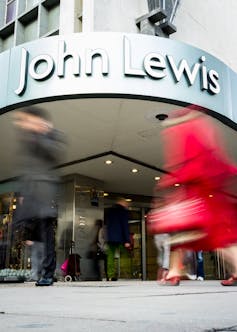This year has been challenging for retailers, to put it mildly. According to the British Retail Consortium, sales were down 1.3% year on year in September, the most recent month available, and the worst since the consortium’s records began in 1995. The summer wasn’t much better, with sales down 0.5% in August and up only 0.3% in July – itself a record low. The Centre for Retail Research says it is anticipating less than 1% growth in real terms for the year as a whole.
As retailers cross their fingers for an end-of-year turnaround, Black Friday is supposed to provide a lift in retail sales on November 29. The great sales event imported to the UK from the US in 2010 is all about trying to attract business away from competitors and boosting profits by maximising sales. Yet in its tenth year, Black Friday seems to be flagging. How useful is it likely to be in attracting customers this year?
Traditionally the first Friday after Thanksgiving in the US, Black Friday began in the UK as a single-day event to encourage customers to get the best deals ahead of the Christmas period. The media ran lots of stories about queues of customers waiting agitatedly outside stores, desperate to get their hands on the best deals. Store doors would be flung open and chaos would ensue for retail staff and customers – just like in America.
Long John silver? pxl.com
Now, however, Black Friday isn’t surrounded by the same air of buying panic. Last year’s event produced the lowest sales peak in the UK since it was introduced. This might be because it isn’t just a one-day event anymore. Click on most retailers’ websites, or walk into your local shopping centre, and Black Friday deals have been available in the days leading up to November 29. Leading retailers such as Amazon, John Lewis and Curry’s PC World are all examples.
Extending Black Friday into a week-long event gives customers greater opportunity to browse, compare and consider their purchasing decisions. It reduces the opportunity for a competitive advantage and limits a “buy now, think later” mentality in consumers. It undermines the sense that this is the sale of the year.
Another day, another sale
It also feels increasingly like Black Friday is just another sale among a swathe of sales throughout the year. In these troubled times, discounting has become a prevalent feature of the retail industry – greatly assisted by the ease of making price comparisons online. According to the 2018 KPMG Annual Retail Survey, 57% of consumers used the internet to find the best deals before making a purchase.
The net result is an air of retail desperation which may be making consumers increasingly immune to sales offerings – not to mention apathetic and sceptical. As many as 20% of shoppers are not convinced that Black Friday deals are genuine, for instance. In addition, 29% of customers feel that Black Friday offers are not exciting. They may have a point: when I browsed the Amazon Black Friday toy deals, for instance, there were very few offers for big brands such as Frozen 2 or L.O.L. Surprise.
Worse, 48% of consumers have reported that they are not interested or don’t intend to buy on Black Friday. It seems to have become a level of background noise within an orchestra of endless sales, where it is unclear when one sale ends and another one begins.
True, one could argue that a lot of people remain interested in Black Friday sales. Many will use it as a welcome opportunity to treat themselves and get ahead in their Christmas shopping. But if Black Friday is to keep enthusing consumers, it has to be more than just another sale. It has to grab people by the purse strings with discounts that genuinely seem unmissable. Otherwise, what makes Black Friday the sales event of the year? As this latest Black Friday arrives, you can almost feel the collective shrug amongst consumers.



 McDonald's Changes Up Its McCrispy; Adds New Cajun Chicken Sandwiches to the Menu
McDonald's Changes Up Its McCrispy; Adds New Cajun Chicken Sandwiches to the Menu  PUMA and Mercedes-AMG PETRONAS F1 Team Launch Crews Go Summer Collection
PUMA and Mercedes-AMG PETRONAS F1 Team Launch Crews Go Summer Collection  Starbucks Rolls Out New Spicy Lemonade Refreshers for Spring
Starbucks Rolls Out New Spicy Lemonade Refreshers for Spring  Is attachment theory actually important for romantic relationships?
Is attachment theory actually important for romantic relationships?  Why are blooper reels so funny?
Why are blooper reels so funny?  HSBC Reportedly Axing Dozens of Additional Investment Banking Jobs in Asia
HSBC Reportedly Axing Dozens of Additional Investment Banking Jobs in Asia  In a time of information overload, enigmatic philosopher Byung-Chul Han seeks the re-enchantment of the world
In a time of information overload, enigmatic philosopher Byung-Chul Han seeks the re-enchantment of the world  If you squat in a vacant property, does the law give you the house for free? Well, sort of
If you squat in a vacant property, does the law give you the house for free? Well, sort of  OpenAI CEO Sam Altman's Worldcoin Unveils Human-Centric Blockchain, World Chain
OpenAI CEO Sam Altman's Worldcoin Unveils Human-Centric Blockchain, World Chain  Burger King Announces Comeback of Its Halloumi Fries in the UK
Burger King Announces Comeback of Its Halloumi Fries in the UK  McDonald’s Korea Hits Record Revenue Amid Localization and Digital Innovations
McDonald’s Korea Hits Record Revenue Amid Localization and Digital Innovations  PepsiCo Issues Recall for Schweppes Ginger Ale Over Sugar Content
PepsiCo Issues Recall for Schweppes Ginger Ale Over Sugar Content 
































